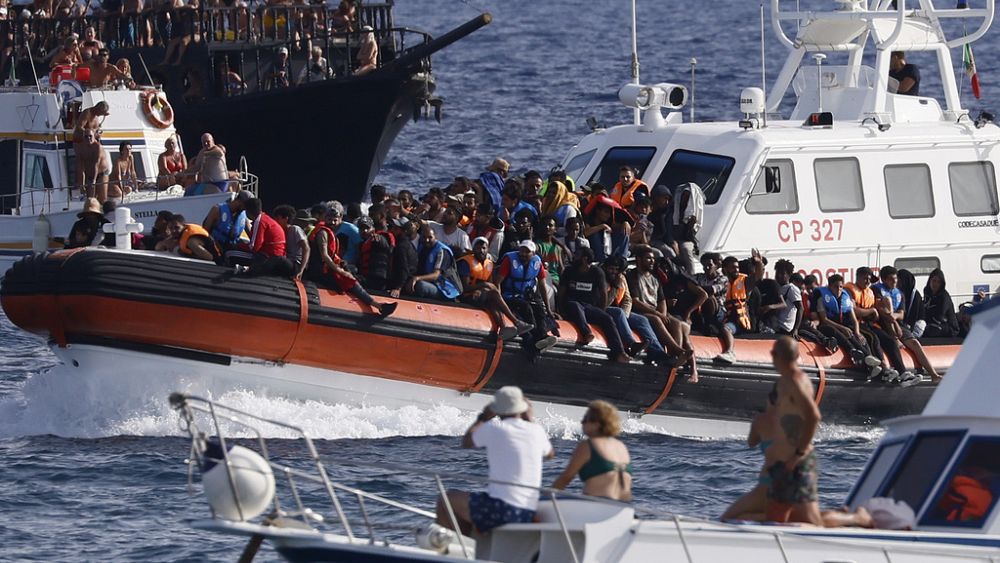His Italian counterpart, Matteo Piantidosi, received in Rome French Interior Minister Gerald Darmanin to “help Italy secure its borders,” following the influx of migrants to Lampedusa.
French Interior Minister Gerald Darmanin arrived in Rome on Monday evening, where he delivered a message of “firmness” in the face of clandestine crossings of the Mediterranean Sea, following the influx of migrants to the Italian island of Lampedusa.
“At the request of President (Emmanuel Macron), I will go to Rome” to offer Italy help in “controlling its external borders,” the main gateway to Europe from North Africa, Darmanin said on Monday.
Between Monday and Wednesday, about 8,500 people, more than the total population of Lampedusa, arrived on 199 boats, according to the United Nations migration agency.
This situation has put the island’s reception capacity under severe pressure, generated political shock in Italy and reopened the thorny issue of European solidarity regarding the reception and distribution of asylum seekers, and support for countries on the front line of these arrivals.
Gerald Darmanin, however, stressed his determination to show “firmness” and that “it is not possible to send a message to people who come to our (European) lands that they will be welcomed no matter what.”
“We must apply European rules,” he added, adding that France would be able to “welcome” people persecuted “for political reasons.” But in “60%” of cases, “they come from countries like Côte d’Ivoire, Guinea and Gambia,” where “there is no humanitarian issue.”
New procedures in Italy
“We must protect the external borders of the European Union and, above all, immediately consider asylum applications and, when they are not eligible, send them back to their country,” he said.
This was a message addressed to the right-wing and far-right government in Italy, whose leader Giorgia Meloni on Sunday criticized its European partners for failing to show solidarity with Italy, which has received nearly 130,000 people since the beginning of the year, almost double the number in 2022 during The same period.
In Paris, it is noted that Rome has not yet requested the distribution of migrants, and Meloni is persuaded to examine asylum applications in Italy while pressuring the Tunisians to better control departures.
Without waiting for a European response, the Italian government approved on Monday new measures aimed at stopping the flow of arrivals, in particular by establishing more detention centers for migrants whose asylum applications have been rejected, and increasing the maximum period of such detention from four to eighteen. Months.
On Sunday, European Commission President Ursula von der Leyen presented a contingency plan for the Lampedusa region.
This ten-point aid plan, designed to deal with emergency migration flows towards Italy, provides for a better distribution of asylum seekers between European countries, as well as facilitating returns.
It is supposed to combine a firm stance against smugglers and facilitate legal entry into Europe for asylum seekers.
“Reworking old recipes”
Italy’s European partners, the first country to enter the EU via this migration route, must do their part, the European Commission president said on Sunday.
French diplomat Catherine Colonna agreed at the United Nations on Monday that “the solution must be in cooperation between the Europeans” and “between the Europeans and Tunisia.”
In a joint statement, more than 80 associations, including marine rescue NGOs, denounced “the old recipes that the European Union has been reformulating for decades, all of which have failed.”
For her part, Marine Le Pen, head of the National Rally party in the French National Assembly, criticized the European Union on TF1, and called for the establishment of a “legal wall” against immigration.
In France, the authorities are anticipating a huge influx of migrants at the Italian border, in the wake of the new arrivals, and are looking to create a “space” of one hundred additional detention places at the border police headquarters in Menton.
The central Mediterranean is the world’s most dangerous maritime migration route, with more than 2,000 migrants killed since the beginning of the year, according to the International Organization for Migration.

“Unapologetic tv specialist. Hardcore zombie trailblazer. Infuriatingly humble problem solver.”







More Stories
Stand News editors convicted in sedition case
Latest Baysail sinking: Mike Lynch’s wife ‘didn’t want to leave boat without family’ as crew investigated
WFP halts Gaza operations after repeated shooting at aid vehicle